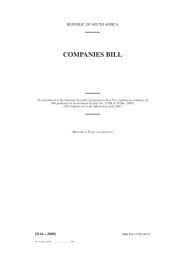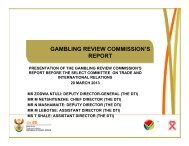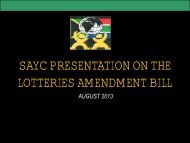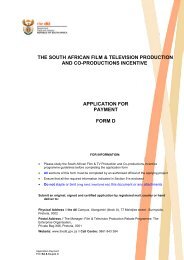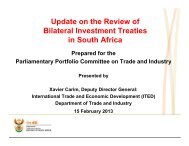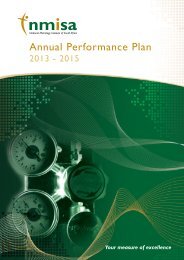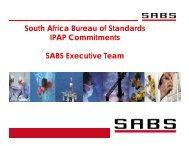Copyright Review Commission Report - ICT Law and Regulation ...
Copyright Review Commission Report - ICT Law and Regulation ...
Copyright Review Commission Report - ICT Law and Regulation ...
- No tags were found...
You also want an ePaper? Increase the reach of your titles
YUMPU automatically turns print PDFs into web optimized ePapers that Google loves.
16.4.14 SWISSPERFORM: CHF4 millionIn 2008, the 10% allocated to cultural <strong>and</strong> social purposes was paid to the following institutions: Phono area: CHF2,2 million, of which: 35% = CHF765 000 to the Schweizerische Interpretenstiftung SIS (Swiss Performing Artists‘ Foundation); 35% = CHF765 000 to the Phonoproduzentenfonds (Phonographic Producers’ Fund Foundation); <strong>and</strong> 30% = CHF670 000 to the Stiftung für Radio und Kultur Schweiz (Swiss Foundation for Radio <strong>and</strong> Culture). Audiovisual area: CHF1,8 million, of which: 80% = CHF1,45 million to the Schweizerische Kulturstiftung für Audiovision (Swiss Cultural Foundation forAudiovision); <strong>and</strong> 20% = CHF350 000 for provident care <strong>and</strong> aid purposes was distributed to Schweizerische Interpretengesellschaft(Swiss Performing Artists Society, SIG), Suisseculture Sociale, Artes et Comoedia Foundation, CAST ProvidentCare Foundation, Film <strong>and</strong> Audio vision Provident Care Foundation (VFA). See http://www.swisscopyright.ch/7. UNITED KINGDOM7.1. INTRODUCTIONA benchmark study was conducted of the collective management of copyright in the United Kingdom. A range ofstakeholders were consulted, including: the British Musicians’ Union; the Intellectual Property Office (<strong>Copyright</strong> <strong>and</strong> IPEnforcement Directorate); the Phonographic Performance Ltd (PPL); the <strong>Copyright</strong> Licensing Agency (CLA); thePerformance Rights Society (PRS); <strong>and</strong> UK Music. These entities not only made time available to conduct the interviews, butalso made numerous valuable documents available to Professor Pistorius to inform the South African process.7.2. STRUCTURE OF THE COLLECTING SOCIETIESMusic (public performance) has two collecting societies: PPL collects on behalf of performers <strong>and</strong> record labels <strong>and</strong> the PRSAlliance collects on behalf of composers <strong>and</strong> lyricists. PRS collects <strong>and</strong> distributes royalties for musical works that have beenperformed or played. MCPS collects <strong>and</strong> distributes royalties for musical works that have been reproduced or copied. PRS<strong>and</strong> MCPS are two separate collection societies joined together in an alliance – the MCPS-PRS Alliance – to deliver bettervalue for their members. PRS for Music is the public br<strong>and</strong> name for this alliance.The PRS was incorporated in 1914 as a non-profit company limited by guarantee. The PPL was formed by EMI <strong>and</strong> Decca inMay 1934. PRS administers the rights of public performance, broadcasting <strong>and</strong> diffusion by cable on behalf of their membersconsisting of:a) composers of music;b) authors of lyrics;c) publishers of such music <strong>and</strong> lyrics, <strong>and</strong>d) successors in title of deceased composers <strong>and</strong> authors.- 156 -





